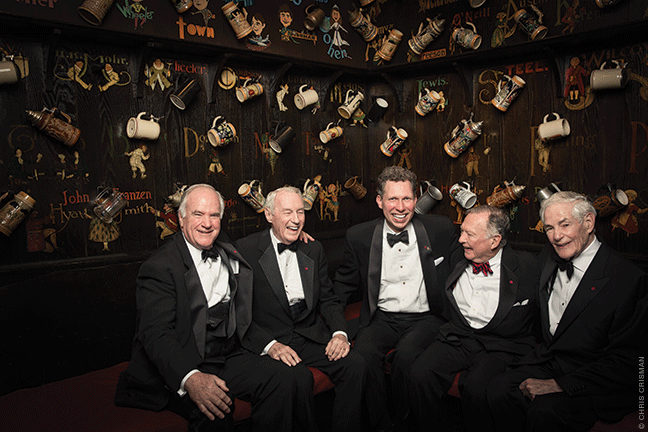
And singing. And dancing. And joking. And cross-dressing. A century and a quarter after its first production in 1889, Mask & Wig—the “oldest all-male collegiate musical comedy troupe in the United States”—remains the one there’s only room for.
BY DAVE ZEITLIN | Photography by Chris Crisman C’03
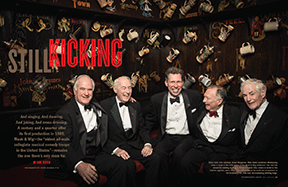
Plus: More Mask & Wig
As Bruce Mainwaring C’47 is vividly recounting the years during World War II when he was enrolled in the V-12 Navy College Training Program, a Penn graduate from the same era bursts into the room, his boundless energy belying his 89 years.
“Bruce Mainwaring!” exclaims John Hackney W’50. “Nice to see you!”
“Nice to see you too!”
“I’ll sit where I normally sit,” Hackney says, taking a spot on the piano bench inside the Bryn Mawr home of Steve Goff C’62, who had arranged, for the sake of a curious reporter, a get-together with some of the most senior alumni of the Mask and Wig Club—Penn’s famed all-male collegiate musical comedy troupe, the oldest of its kind in the United States.
Just a couple of months earlier, Hackney sat at another piano to perform the song “Daddy”—written for Mask and Wig more than 70 years ago by the late actor/singer/jazz pianist Bobby Troup W’41—in front of the hundreds of “Wiggers” on hand for the club’s 125th anniversary gala at the Annenberg Center.
But today Hackney is not here to sing—at least not yet. Nor is he here to join in on the discussion of World War II, even though he took part in the D-Day invasion. “I don’t talk about that,” he says, his voice softening and his eyes lowering.
Just then, he jumps off the piano bench and begins flipping through an old album that chronicled his years in Mask and Wig following his return from the war. Why think about Normandy when he can instead show off pictures of himself happily dressed in drag (“I was always a lady in the shows because I was short,” he says) or 65-year-old newspaper clippings with huge headlines about the historic club?
“We were competing with Broadway shows in our day,” Hackney boasts. “We got big writeups in the [Philadelphia] Inquirer.”
As the pages in the album turn, some other of Mask and Wig’s most distinguished alums join in the conversation, recalling the shows they performed in and the memories they made. Sitting between Hackney and Mainwaring—two past Mask and Wig presidents—is Charlie Meredith W’57, a former undergraduate chairman. On the other side of the room, Goff—the club’s active historian—is bounded by a crackling fireplace on one side and Mike Huber W’53 ASC’61, Penn’s former director of alumni relations (and publisher of the Gazette), on the other.
By the time past president and historian Bryan Margerum C’88 arrives for lunch, the funny stories are flowing like the Bloody Marys that are being poured—each story bringing to life the unique tradition of the 125-year-old group that’s been kept alive by alums like these.
Train Tours and The Ed Sullivan Show
Before serving crab soup and Cobb salad to his guests, Goff points to the center of the table, where an old Pennsylvania Railroad System menu is sitting beside a model of the train car the Mask and Wig club members rode, slept, and partied in during their annual tours to the finest East Coast theaters.
It was a nice memento to include with lunch but probably unnecessary; these Wiggers, after all, didn’t need much prodding to remember the train tours from the first half of the 20th century that remain one of the most fascinating parts of Mask and Wig lore. Meredith, who graduated in 1957, was one of the last people to take the club’s private train to performances, and it’s not long before he has the room howling in laughter recalling some of the high jinks that happened on board.
Here’s one story: Just as the Mask and Wig Club arrived at Erie or Rochester—Meredith can’t remember which one—the train holding members of Princeton’s touring musical-comedy troupe—the Princeton Triangle—was pulling out of the station. As Meredith tells it, Wigger Nick Barnes W’56 was standing by both trains, wearing a tuxedo that made him look formal enough to be a Princeton Triangle performer, just as one of that ilk approached, out of breath from racing down the stairs of the station. He asked which train was Princeton’s, and Barnes, in a pure moment of impulsive mischief, pointed to the Penn train. The breathless kid happily got on board—just as his actual train pulled away. “We had him for a couple of days,” Meredith says with a wicked grin. “We worked him into the show. A couple of days later, our paths crossed again and we returned him to Princeton.”
Playing pranks seems to have been a crucial aspect of Mask and Wig’s trips. When the Wiggers arrived in Buffalo—after stops in Harrisburg, Pittsburgh, and Erie and before they got to Syracuse and Rochester—Meredith said they’d paint the “balls” of the city’s buffalo statue red and blue. (The Princeton Triangle folks would then paint over the Penn colors with their own orange and black colors.) But even if they did cause a little bit of trouble, each city’s Penn alumni society would greet the famous Philadelphia performers with cocktail parties and young ladies (“debutantes,” Hackney calls them). Then, after performing their show at big theaters like New York’s Metropolitan Opera House, they’d get back on the train, have a few drinks, put on an impromptu performance in their pajamas (there was a piano in the club car), go to sleep—and wake up the next day in another city, where they’d do it all again.
“When you see some of the pictures of the tours, they were royalty,” Goff says. “It was huge.”
Goff joined Mask and Wig just after the train tours stopped (the tours themselves have continued, but the club now takes buses and planes to its destinations), which was upsetting to him—not least because his dad worked for the Pennsylvania Railroad for 44 years. But he still gets a kick out of how revered his singing and dancing predecessors were in the old days.
While digging through the club’s archives not long ago, Goff discovered a 1938 newspaper clipping from Warren, Pennsylvania. As the Great Depression waned at home and Europe drifted toward war, there, blasted across the top of the front page, was a huge headline about Mask and Wig’s arrival in town. At first Goff thought the newspaper must have been doctored, but on further reflection he realized it was authentic evidence of Mask & Wig’s stellar reputation.
Goff certainly felt some of that as an undergraduate when he got to dance, as a member of the club’s long-running “female” kickline, on The Ed Sullivan Show, the iconic TV variety program that ran on CBS throughout the 1950s and 1960s. Meredith performed on the show, too—three times, in fact—and many of those memories came flooding back to him when he picked up a newspaper recently and saw an article about the 50th anniversary of the Beatles’ historic appearance on Ed Sullivan. “Oh, we were better [than the Beatles],” Meredith laughs. “We just didn’t have the girls squealing as much.”
The girls did like them, though. Hackney remembers nearly getting left behind in Cincinnati because a couple of ladies had asked him and a fellow Wigger to come up to their hotel room. But a chaperone dragged them away, foiling their plans and preventing Hackney and his friend from breaking Mask and Wig’s self-determined streak of nobody ever missing a train. During a different trip, Hackney briefly met a girl in Bridgeport, Connecticut and, after graduating, bumped into that same girl during a business trip. “I know you,” the girl said. “You’re from Mask and Wig!” Not long after that, the two of them got married.
As Hackney tells that story, it’s easy to see why he returns to so many Mask and Wig events to sing “Daddy.” As wonderful as it is for later generations of alumni to see a soon-to-be-90-year-old World War II veteran play the piano for them, it’s perhaps even more of a thrill for Hackney to stay involved in a club that’s shaped his life in so many ways. Toward the end of lunch, as he takes one of his final bites of Cobb Salad, he tries to sum up his feelings about Mask and Wig.
“The one thing we haven’t mentioned yet,” Hackney says “is you make very good friends that stay with you for the rest of your life.”
“Because we lived with them all year long,” Meredith chimes in. “We would rehearse six days a week and rehearsals would typically last four, five hours. From the fall show to the spring show, we were together as a fraternity. And those friendships last forever.”
“Mask and Wig Doesn’t Really End”
If anyone knows about the friendships forged through Mask and Wig, it’s Tripp Hornick C’02.
During the cocktail hour of the 125th anniversary gala, before Hackney has belted out “Daddy” and alumni from different generations have sung medleys of Mask and Wig songs from every era, Hornick is holding a drink and wearing the kind of smile that, by the looks of it, is a frequent visitor to his face. “I’ll introduce you to a bunch of idiots,” he says. “Because that’s what we are—a bunch of idiots.” He then sees an old classmate, makes a crude comment, and then talks about the fraternity where everyone loves each other.
It’s that dynamic—the ability to make fun of each other while knowing there’s nothing but love behind the comments—that helped Hornick get through the toughest year of his life. Two weeks before the start of his senior year, Hornick—then the secretary treasurer of Mask and Wig, as well as an actor and producer—was diagnosed with testicular cancer. One of the first things he did was call a meeting with the other upperclassmen in the club.
“Guys, I’m going to have some problems this semester,” he remembers telling them. “I just got diagnosed with cancer. I don’t anticipate I’m going to die by any stretch of the imagination. I do anticipate losing a very good friend of mine, but hopefully there will be more breathing room as a result.
“I still need to be deeply involved. I need the club to let me be involved. And we’ll all get through it.”
The club did more than just let him stay involved, offering the kind of support Hornick never could have even imagined. Because he wanted to be treated at Memorial Sloan-Kettering Cancer Center in his native New York City, his days went something like this: get radiation at 7:15 a.m., hop on a train to Philly, go to class, throw up, take a nap, “throw up again and continue throwing up,” go to Mask and Wig rehearsal and, at around 11:30 p.m., take the last train back to New York. Then, he would do the whole thing again the next day.
It was a brutal daily routine, but a few of his Mask and Wig friends made it easier by sometimes accompanying him to and from New York. One of them, he says, even managed to get inside the radiation control chamber, where he asked a doctor if he could press the button. The doctor told him that could kill Hornick, to which the Wigger allegedly replied, “Don’t worry, he can take it.”
“It’s the classic idea of a bunch of guys trying to laugh through the pain—but taking care of each other,” Hornick says. “And you know, there’s a reason why I stuck through. Wig really got me through that.”
A week after finishing radiation, Hornick was on stage for Mask and Wig’s fall show—about 55 pounds heavier due to a terrible reaction he had from the radiation. And the minute the lights came on, before Hornick could sing the first line of the first song, the audience burst into applause. “I don’t know how they knew but they knew,” he says. “It was a very special moment.”
Hornick is now perfectly healthy but there’s not a day that goes by when he doesn’t think about what Mask and Wig did for him. Which is why he’s been on the alumni board of Wig’s Graduate Club—which is responsible for many of the decisions that guide the Undergraduate Club—for the past decade, where, among other duties, he helps set up the annual tour.
“To be perfectly blunt, I get no great joy to plan the tour,” Hornick says. “The great joy is ensuring that more classes of undergraduates have the ability to have as good, if not a better, experience in Mask and Wig as I had. And every single person on the board is there for that reason.”
Jim Praley C’76 would probably agree with that sentiment. Now in his first year serving as the Graduate Club’s president, Praley downplays his responsibilities, joking that his main role is “just to thank people for doing a good job.” But even though he leaves the performance-related responsibilities to the students and most of the day-to-day financial responsibilities to other alumni board members, he recognizes the duty he has to uphold the club’s tradition.
“We’re always thinking about what we can do to make sure this continues on,” Praley says. “That’s really the role of alumni. [The students are] the performers. It’s their show. Our job is to enable that and make sure it continues.”
Like many future dedicated Wiggers, Praley hadn’t heard of the club when he first arrived at Penn as a freshman. But after deciding to quit the lacrosse team, he was looking for another extracurricular activity and noticed a Mask and Wig flyer in Houston Hall. He asked his RA what she knew about the club, and she told him, “They’re the funniest people on campus. If you can get in, that would be great.” He then asked his cousin—a senior at Penn—the same question and his cousin told him, “They’re the funniest people on campus. If you can get in, that would be great.” That settled it for Praley, and when he realized he probably wasn’t good enough to dance, sing, or play an instrument, he lobbied to be a stage manager. He got the job and has remained an active Wigger ever since.
Like Praley, Noah Goldstein C’14 has been behind the scenes more than he’s been on stage. But as the current Undergraduate Club chairman and member of the business staff, Goldstein admits that Mask and Wig helped him grow from a “not especially sociable person my freshman year” into someone who says “the best part of Mask and Wig for me are the people.” Goldstein often reaches out to alums to talk about their experiences in the club and made sure to send Hackney a long email after the World War II veteran sang at the gala. Perhaps one day he will be the old guy coming back to Mask and Wig’s 175th or 200th anniversary party.
“I can’t imagine my college experience without Mask and Wig, and moving forward, I can’t imagine not having any involvement in Mask and Wig,” Goldstein says. “Mask and Wig really doesn’t end when you graduate. It’s just a transition into a different phase.”
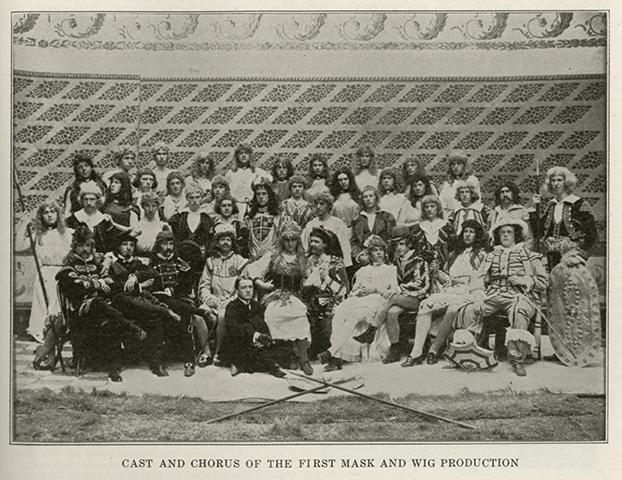
The Quirky Clubhouse
“This building has a lot of history for me,” Steve Goff says one day, as he rests his hand on a piano and stands beside the wood-paneled bar inside Mask and Wig’s clubhouse at 310 South Quince Street, a narrow side street in Center City.
In truth, the building—which has been owned by Mask and Wig since 1894 and is listed on the National Register of Historic Places—has a lot of history for everyone. The walls in the first-floor Grille Room are almost entirely covered with paintings, ceramic mugs, and caricatures of old Wiggers (which everyone gets when they’re elected to the Graduate Club), and the stairwell leading up to the performance room is lined with old photos from throughout the 20th century.
But it’s hard to imagine anyone who’s had more experiences inside the clubhouse than Goff, who abides by the principle that “Mask and Wig doesn’t really end.” It was at that same bar, after all, that Goff, as a young member of the Graduate Club and a producer of the club’s shows in the mid-1960s, was hired as Penn’s business manager for performing arts, where one of his main responsibilities was organizing Mask and Wig’s tour. He later went on to serve as the assistant managing director and later managing director of the Annenberg Center. Now retired, Goff is still quite active on the board and, remarkably, has a streak of going to opening night of the spring show for 57 straight years, often braving the January snow and ice to get to Quince Street from his home in Bryn Mawr. There is also a Mask and Wig tradition called Goff Night, where he and a couple of other older alums buy all the tickets for one of the performances. “He’s kind of the heart and soul of the club,” Praley says.
The clubhouse is empty now as Goff walks around the creaky floors, past the baby grand piano and up to the bar that sits beneath the antler-covered chandelier, taking on the role of tour guide.
“Supposedly, from time to time, this was used as a dissecting room for Jefferson Hospital’s anatomy courses,” he says. “We have no real firm proof of that but it’s been carried down.” Before that, Goff says, the location served as a church and a stable. When Mask and Wig purchased it, they employed the services of prominent architect Wilson Eyre (also one of the architects of the Penn Museum) to design the interior, which was decorated with a collection of early artwork by Maxfield Parrish.
Nearly a century later, when Mask and Wig faced financial hardship—“In the early ’50s when TV came in, it started to cut down on our audiences and we started to lose money,” Goff says—the Graduate Club (which owns the building) made the decision to sell a few of those paintings, the most famous of which was Old King Cole, for $725,000 in 1996. (They later had the painting replicated, and the copy still hangs prominently in the Grille Room.)
“I was the president when we were going to go broke,” says Mainwaring. “I told my friends it was either Parrish or perish.”
The Old King Cole sale started the club’s first endowment—which today stands at nearly $2 million—and allowed them to make improvements to the clubhouse five years ago [“Window,” Jan|Feb 2010]. Among the renovations were adding facilities for handicapped accessibility, including an elevator, as well as air conditioning. But the upgrades also came with a scare, when an electrical fire broke out during construction.
“We lucked out,” Goff says. “Someone happened to be walking by and smelled smoke around 2 a.m. and called the fire company. If that hadn’t been caught early, this place would have gone right up.”
The place survived the fire without much damage, but maintaining such an old building still comes with its set of challenges. As Goff walks upstairs, he hears a loud purring noise and goes backstage to find an industrial-sized fan turned on at full blast. Building manager Kate Rice, who handles rentals (a main source of income for the club), is standing nearby and explains that water came through the roof and she needs to find a roofer. “It’s one step forward and two steps back,” she sighs.
But about a month later, those maintenance problems hardly seem worrisome as the clubhouse comes to life for the debut of this year’s spring production, Wishful Sinking. And for Goff, there’s nowhere else he’d rather be than making his 57th straight opening-night appearance. Here, in the middle of a packed house of alums, students, and family members of the cast, he’s even something of a celebrity. “Your seats are always reserved,” a kid in a tuxedo tells him, pointing him to the first row. After he settles in, a recent alum approaches to say he’s been to opening night for six straight years and has just “51 more to go” to catch him. Goff smiles, then turns his attention to the stage as the show—about shenanigans aboard a doomed cruise ship—begins. His smile never disappears, and when the show ends, he’s asked how this one compares to the 56 other ones he’s seen.
“It’s very high on the list,” he gushes with apparent conviction, before walking downstairs to have a glass of wine and sing with his friends, delaying the cold and the snow that await him outside the clubhouse.
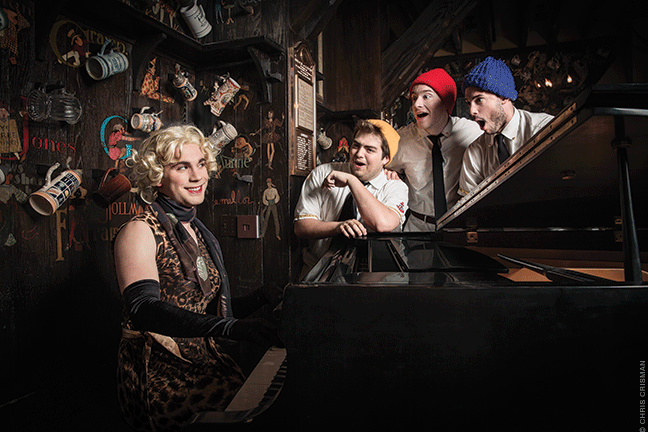
Professional Quality
Goff’s assessment of this year’s show seems to match the consensus. While older alums can sometimes be critical of the sophomoric humor that inevitably finds its way onto the stage—as well as the over-the-top hoots and hollers that come from the crowd when they see their friends dressed in drag—many of them agree that Wishful Sinking was filled with truly clever jokes, catchy tunes, and the kind of acting talent you might find at a professional production. In other words, it was the perfect show to commemorate the club’s historic anniversary.
“The feedback I’ve been getting this year has really been extraordinary,” says longtime Wigger Neil Radisch EAS’86. “A lot of people have been saying that if you’ve never seen a Mask and Wig Show, or you have friends who have never seen one, this is the one to bring them to. They really have found a sweet spot in the writing where it appeals to pretty much everybody.”
Radisch himself is one of the main reasons Wishful Sinking has been so well received. For many years now, Radisch has volunteered his services to compose all of the music and write most of the lyrics for Mask and Wig shows—this one included. He lives in Connecticut, so it’s a bit of a grind to spend time working with the undergraduates on the show, which includes a weeklong stint in Philly during dress rehearsals. But now that he’s retired from one of his careers as a computer programmer—and his wife, who’s an attorney, is able to support the family financially—he can afford to do it.
Even more than that, Radisch feels something of an obligation to the club for launching him on the path to being a composer, of which he’s enjoyed some professional success (including once producing an off-Broadway show). It all started when he was a sophomore and some fellow Wiggers burst into his fraternity house to tell him, “Dude, you have to write some songs.” Considering he had never before written music, Radisch kindly asked if they were joking. They were not, so Radisch went to work writing music with fellow Wig member David Goldstein C’85, who would go on to become his writing partner for many years.
“Having never done it before, I just took chords from songs I knew and wrote new melodies to it and hoped for the best,” Radisch says. “And over time, I sort of developed a knack for writing from scratch.”
Shortly after graduating, Radisch was hired as a paid staffer to compose music for the club, and he later co-wrote the entire 100th anniversary show with Goldstein.
“That sort of changed things,” Radisch says, “because then I was in a position where everyone looked to me to continue writing all of the music.”
He did that off and on for a number of years, before recently diving headfirst into the club. Now he writes all of the music, composes all of the orchestrations, and works more closely with the undergraduates—all without accepting a dime. He even compiled all of the medleys for the 125th anniversary gala—A Musical History of the Mask and Wig Club—which fittingly concluded with a song he co-wrote for the club’s centennial: “We’re Still Kicking.” And as he played the piano on the Zellerbach Theater stage that night, the hundreds of alums in the crowd sang along, in many ways marking their own place in the club’s history: “Yes, we’re still kicking after all of these years.”
“As a young composer who was working for tuna-fish sandwiches, to have a group willing to pay me to write their music was just absolutely astounding,” Radisch says. “I’ve always felt a little indebted to them for doing that. And over the years, I’ve become incredibly attached to the organization and I’ve always wanted to see them put out the best possible product.”
Radisch says he’s the only non-student working on the actual performances who doesn’t get paid, as Mask and Wig employs a lean professional staff to help get the show on its feet. Among the paid professionals are a director, costume designer, set designer, and choreographer—but the undergraduates handle all of the writing for the show’s “book.” This differs from the early Mask and Wig years, when the shows were written by the graduate portion of the club and developed entirely by well-paid union members, including professional stagehands and a professional orchestra. Based on his reading about the history of the club, Radisch says that the undergraduates “had little artistic stake in the show, other than getting up there and performing.”
That dynamic began to change in the early 1960s when the shows were moved from Irvine Auditorium to the Quince Street clubhouse (which, until then, had been mainly used for parties and rehearsals). While performing on Penn’s campus was convenient, says Goff, the acoustics in the old Irvine before its extensive renovations in the 1990s were “awful.” Attendance at the shows had been dropping; and between that declining revenue and the lavish productions and first-class train travel, the club was bleeding money. It was around that time, too, that the show’s structure changed from a burlesque to a revue format in which topical sketches were interspersed with dancing. And to make sure the sketches stayed, well, topical, the undergraduates would soon take control of the writing.
“We began those before Saturday Night Live,” Goff says. “When that came along, people were like, ‘Oh, you’re like Saturday Night Live!’ We said, ‘Uh-uh, Saturday Night Live is like Mask and Wig.’”
The shows eventually moved back toward a musical book format, but the undergraduate influence has continued to steadily grow, both on stage and in the student-run pit orchestra. And, thanks in large part to a brutally tough audition process and sustained popularity on campus, the quality has never suffered because of it.
“One of the things about the show is there’s a professional quality to them,” says Huber, who in his years as director of Alumni Relations, coordinated Mask and Wig’s first-ever trips to the West Coast. “There’s a real professional feeling there that the fellas in the show take great pride in.”
It helps, of course, that there are still a handful of professionals working behind the scenes—even “professionals” like Radisch who don’t get paid and only started writing music for the club when they got “roped into the whole thing.” Lucky for him, because now he never wants to quit doing it.
“Until it no longer interests me, I don’t see any reason to stop,” Radisch says. “And frankly, I can’t imagine ever losing interest.”
Only Room for One
One day recently, while trying to wrap his head around the history of Mask and Wig, Noah Goldstein decided to Google the year of the club’s founding—some 100 years before he was born and 110 years before Google existed. When he discovered that a few states were admitted to the Union that year (North and South Dakota, Montana, and Washington, the 39th through 42nd to join), his awe of the club’s tradition only grew. “There has been so much history since the formation of Mask and Wig,” the club’s undergraduate chairman says. “It’s incredible to think about.”
While a lot has naturally changed since 1889—both within Mask and Wig and the world around it—the club has always tried to honor its past and not stray too far from its roots. For many years, the club held a Founders’ Night dinner to honor the forward-thinking men, chief among them Clayton Fotterall McMichael C1891, who decided Penn needed a theatrical troupe that would, according to the Mask and Wig website, “get up in frocks and spoof everyone and everything, naturally.” Those dinners happened every year until all of the founders passed away, but the spirit has carried on through Club Night, when only Mask and Wig members, including many of the most senior alumni, are invited to the final run of the annual production. “These days people like John Hackney, they’re not our founders but they’re the closest we can get,” Radisch says. Adds Margerum: “That’s certainly part of the magic of the group—that link to the generations before you.”
Of course, the cultural impact of Mask and Wig has changed from generation to generation. The club no longer appears in the finest theaters and no longer travels the country in its own Pennsylvania Railroad car. Gone are the days when Frank Sinatra covered Mask and Wig tunes and Hollywood movies paid homage to the club. (In the 1937 film Varsity Show, two men are arguing in a theater when one discovers that the other’s son is a student at Penn and in Mask and Wig—at which point the orchestra members in the theater stand up and start singing the club’s original song, “Only Room For One.”)
Yet in many ways the club’s core principles have endured. While diminished in lavishness and glamor, the annual tours, for instance, are still a point of pride and something every Wigger relishes. “By the time you finish school, you’ve really had a great experience seeing the country,” says Margerum. And the high jinks on the trains have simply been replaced by high jinks on planes. One of Praley’s fondest memories is of a Wig member grabbing the microphone on a near-empty flight and serenading three blonde stewardesses with “California Girls.”
Despite some occasional pushback, Mask and Wig has remained all men—which allows them to hold on to the title of “oldest all-male collegiate musical comedy troupe in the United States.” And while the only comparable collegiate groups—Harvard’s Hasty Pudding Club and the Princeton Triangle Club—have since gone co-ed, the clamoring for women to join Mask and Wig is not too strong, they say, because Penn has a successful all-female sketch comedy group in Bloomers, founded in 1978.
“One of the things about Mask and Wig is this is something no other school has outside of Princeton and Harvard,” Huber says. “It’s really unique to Penn. And that’s one reason why they’ve been so successful with the alumni—they can take some pride in it.”
The Penn community certainly takes a lot of pride in Mask and Wig, even if the club’s reach has lessened on the national stage. The Mask and Wig band traditionally headlines the last day of Spring Fling performances, and Goldstein remembers hearing a story from the mid-1990s when Korn—before it became a famous band, admittedly—was booed off stage as students in the Quad chanted for Mask and Wig. And there was another time during Fling, Goldstein says, when the skies opened up after one song—but instead of running inside, “people just jammed out in the rain.”
Mask and Wig takes a lot of pride in Penn, too. Abiding by its credo “Justice to the stage and credit to the University,” the club has donated a lot of money to the school over the years (see, for example, the Mask & Wig dorm in the Quad, now part of Riepe College House) and has a tradition of entertaining incoming Penn presidents at the clubhouse.
“We take big strides to always represent the University in the best light,” says Hornick, who claims that, in terms of attendance, Mask and Wig is the third-largest draw at Penn, behind the football and men’s basketball teams. “It means a great deal to the club. The club, though technically separate from the University to a degree, wouldn’t exist without it. And everyone in Mask and Wig, I feel, has a deeper love for the University than just about anyone else I know that attended.”
The end of every performance showcases Mask and Wig’s affinity for Penn as the students sing “Men of Pennsylvania” and their own version of “The Red and Blue.” They also make sure to answer the age-old question, “Why is there only one Mask and Wig club?” with a song that dates back to near the formation of the club, the one that was once sung in that black-and-white film nearly 80 years ago, the one that, toward the end of lunch at Steve Goff’s house one winter afternoon, the oldest Wiggers decide to spontaneously belt out in unison:
Because there’s only room for one.
There’s only room for one
So here’s a swig and a toast so big
Straight through the hearts of Mask and Wig
There’s only room for one
There’s only room for one
We drink to you with a toast for two
But there’s only room for one
Hey!
When they’re done singing, the oldest alums of the country’s oldest all-male collegiate musical comedy troupe stand up from the table. “Show’s over!” Meredith hollers, and then, one by one, they walk toward the door, still kicking after all of these years.
Dave Zeitlin C’03 writes frequently for the Gazette and oversees the magazine’s sports blog.


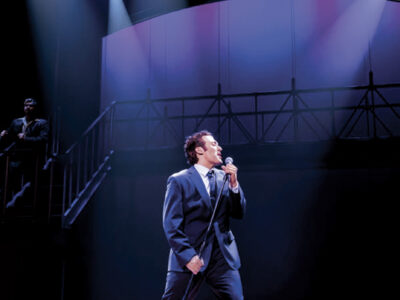


Here’s the 1937 Varsity Show clip referencing Mask and Wig
https://www.youtube.com/watch?v=DmbyJaBUAj4